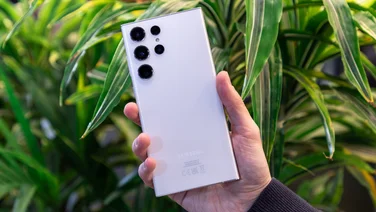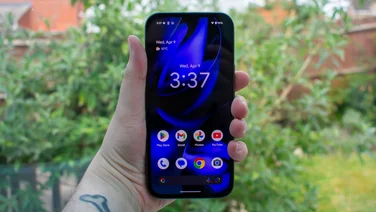To help us provide you with free impartial advice, we may earn a commission if you buy through links on our site. Learn more
- Magnetic Qi2 charging
- Excellent cameras
- Superb display
- Rivals are much faster
- Barely an upgrade
- Battery life is disappointing
Before the official announcements, I was automatically expecting the Google Pixel 10 Pro to be my favourite of the family. I love a compact flagship smartphone and last year’s Pixel 9 Pro was my top choice, so why should this year be any different?
Well, because Google has put far more of its upgrade eggs in the Pixel 10 basket this year, leaving the Pixel 10 Pro feeling like much less of an evolution. We still get the new Pixelsnap Qi2 magnetic wireless charging and the newer Tensor G5 chipset – but otherwise, this is basically identical to the Pixel 9 Pro.
Throw some questionable battery life into the mix and the Pixel 10 Pro doesn’t feel like a particularly worthwhile upgrade. If you have your heart set on the magnets, you’re better off with the Pixel 10. Otherwise, grab a Pixel 9 Pro for a couple of hundred pounds less.
Google Pixel 10 Pro: What you need to know
So just how similar is the Pixel 10 Pro to its predecessor? It’s fronted by the same 6.3in OLED display with the same 2,856 x 1,280 resolution and 120Hz LTPO refresh rate – although the peak brightness is rated a little higher this year (3,300 nits, compared to 3,000).
The selfie camera is the same 42-megapixel (f/2.2) unit and over on the rear, we’ve got the same triple-camera setup: a 50-megapixel (f/1.7) main lens, a 48-megapixel (f/2.8) 5x periscope telephoto camera and a 48-megapixel (f/1.7) ultrawide.
Most of the upgrades are inside, and they’re fairly minor. Bluetooth support now extends to version 6.0, the processor is the new 3.78GHz Tensor G5 and the battery is a slightly larger 4,870mAh cell.
Wired charging is marginally faster (30W, compared to 27W) and there are now magnets in the back of the phone that allow for MagSafe-style magnetic wireless charging at up to 15W with compatible Qi2 chargers.
Price and competition
The Google Pixel 10 Pro starts at the same £999 as the 9 Pro. That gets you the 128GB model but the other configurations are the same price as last year, too: the 256GB version is £1,099 and the 512GB variant is £1,219. New this year is a 1TB model, priced at £1,449, meaning you no longer need to go for the Pro XL to get maximum storage.
The biggest Android competition comes from the Samsung Galaxy S25 Plus, which starts at £899 for the 256GB model, while the 512GB variant is £1,099. The S25 Plus has a larger display and a more powerful processor, but the telephoto camera only offers a 3x optical zoom and it lacks the Pixel’s magnetic charging.
On the Apple side of the fence, we have the iPhone 16 Pro. This currently starts at £899 for the 128GB model, with storage configurations going up to 1TB for £1,499. We get MagSafe charging here and a 5x telephoto camera, just like the Pixel, as well as much faster performance and some of the best battery life we’ve ever seen from an iPhone.
Finally, the OnePlus 13 undercuts all of the competition, costing just £899. For that, you’re getting a powerhouse with the Snapdragon 8 Elite chipset, a large 6.83in display, speedy 100W wired charging and a 3x telephoto camera.
Design and key features
The design of the Pixel 10 Pro is, for all intents and purposes, the same as the Pixel 9 Pro. The measurements are identical – 72 x 8.5 x 153mm (WDH) – it’s once again rated IP68 for dust and water resistance, and there’s a sheet of Gorilla Glass Victus 2 over the display and the rear for scratch protection.
It does weigh slightly more than its predecessor (207g compared to 199g), which can likely be explained by the slightly larger battery and the addition of magnets on the rear for Qi2 wireless charging. PixelSnap is Google’s answer to Apple’s MagSafe feature, and allows you to attach a wireless charger – as well as other accessories like a detachable kickstand – with a strong magnetic connection.
The colour options are different, too. My review sample came in the gorgeous Moonstone, a light blue-grey that feels suitably celestial, but you can also get it in the classic Porcelain and Obsidian colourways or the new Jade.
The software is always a plus point of Pixel phones, with early access to new features and a fantastic seven years of OS updates and security patches, and it’s no different here. The Pixel 10 Pro launches with Android 16, and that software roadmap means it will stay up-to-date all the way until Android 23 in 2032.
Google’s Gemini AI assistant is set up as standard, and you get a couple of new intelligent features this year. Camera Coach recognises the contents of your camera viewfinder and suggests angles, crops and which lens to use to get the best of your shots. Magic Cue is a context-sensitive feature that draws information from your other apps to save you switching between them — providing a reservation time from your calendar when someone asks you in Whatsapp, for instance.
Display
It’s not a bad thing when I say that a Pixel’s display is identical to last year – Google knocked it out the park with the Pixel 9 Pro. This 6.3in OLED panel has a resolution of 2,856 x 1,280 and an LTPO refresh rate that can dynamically adjust between 1Hz and 120Hz.
It gets fantastically bright, too; on manual brightness, I recorded it at 1,334cd/m2, while switching to adaptive and shining a torch on the light sensor pushed it to 1,831cd/m2. It was best when displaying HDR content, where it topped out at a phenomenal 2,089cd/m2.
The default Adaptive colour profile has more vivid colours that work fantastically well with streaming, gaming and the like, but those who prefer more accurate colours will find the Natural profile to be ideal. Here, I recorded an sRGB gamut coverage of 97.4% and a volume of 98.6%, with the average Delta E colour variance score coming back at just 0.72. Anything under 1 is right on the money.
Performance and battery life
The Google Tensor G5 chipset is a solid improvement over last year’s Tensor G4, with a higher peak clock speed of 3.78GHz, compared to 3.1GHz. And it does a decent job in the Geekbench 6 tests, with results that are 17% higher than the Pixel 9 Pro in the single-core benchmarks and 31% in the multi-core.
As tends to be the case with Pixel phones, however, you can get much faster performance from near-enough every other competitor. The iPhone 16 Pro beat the Pixel 10 Pro by 30% in the multi-core benchmarks and the Galaxy S25 Plus beat it by a whopping 61%.
As much as we saw a decent generational uptick in CPU performance, the GPU side of things remained largely stagnant for the Pixel 10 Pro. In fact, the onscreen framerates are a tiny bit worse than last year.
These results are still high enough for the Pixel 10 Pro to be a decent gamer – I ran a few tracks on Asphalt Legends and never noticed any excessive framerate dips or ugly, poorly rendered textures – but those who want the best gaming experience will not find it here.
Either the Samsung Galaxy S25 Plus or the OnePlus 13 will be much better options for intensive 3D gaming, but both are big-screened devices. If what you want is a compact phone, you can still get superior gaming results with the standard Samsung Galaxy S25.
Things get a little iffy as we turn our attention to the battery life, and I’m still not 100% sure what to make of it. In our standard looping video battery test, the Pixel 10 Pro lasted just 21hrs 32mins before the battery died. That’s substantially worse than the Pixel 9 Pro (27hrs 39mins) and generally very mediocre for a phone of this price – as you can see below, the rest of the competition fall in the late 20-hour, early 30-hour range.
This weaker battery life was consistent across the entire Pixel 10 series (barring the Fold, which I’m yet to test), which made me wonder if there was some software fault that is excessively draining the battery. I’m currently investigating this and will update the review accordingly with the results but for now, this is what we’re working with.
If your screen usage is on the more moderate side of things and you’re already in the habit of charging your phone overnight, this weaker stamina doesn’t necessarily need to be a dealbreaker for you. It’s disappointing to see, especially when you can get much better battery life from rivals, but it’s not bad enough that you’ll need to constantly be reaching for a charger throughout the day.
At least not at first. As we all know, battery life does tend to degrade over time so in two or three years time, you might be reaching the end of your tether with it.
I didn’t get a wireless charger to test the new Pixelsnap feature with but wired charging is roughly the same as last year. It technically goes up to 30W now, instead of 27W, but that’s balanced out by the slightly larger battery, so Google’s claim remains that it takes 30 minutes on charge to hit 55%.
Cameras
When it comes to cameras, we’re back to the deja vu, because the camera loadout is a dead ringer for last year. Of all the things that haven’t changed this year, however, I’m least bothered by this, because the Pixel 9 Pro’s cameras were already excellent.
The 50-megapixel (f/1.7) main camera remains a fantastic shooter, producing bright and beautifully coloured images in good lighting. Dynamic range is particularly impressive, with plenty of finer detail in the deep, shadowy areas – helped along by optical image stabilisation (OIS).

With the Pixel 10 getting its own telephoto camera this year, there was a concern that it would feel too similar to the 10 Pro for the latter to be worth spending more money on. While there’s definitely an element of that, the Pixel 10 Pro’s telephoto shooter is superior.
As you can see in the comparison below, both do a decent job of capturing the intricate detail in the flower, but the Pixel 10 Pro has stronger definition and greater dynamic range, and the Pixel 10’s result steers a little hard into the highlights. The focus is a tad sharper on the Pro, as well, more clearly outlining the subject and it more effectively blurs the background.

Night photography is solid, too. There’s plenty of detail extracted from the darker areas, colours are captured in a pleasingly natural manner and artificial light sources are kept in check, avoiding excessive blooming.

And to top it all off, the 48-megapixel (f/1.7) ultrawide camera is one of the best in the business. The combination of a larger sensor and wider aperture than most rivals helps keep the detail level looking strong, and the colour tone is near-enough identical to the main lens.

Otherwise, the 42-megapixel (f/1.7) selfie camera still captures gorgeous portrait shots, with natural skin tones and crisp focus, and the video suite again shoots up to 4K/60fps natively, with the option to upscale to 8K/30fps via cloud processing. It’s all the same as before, but still decent enough that it’s not a massive deal.
Google Pixel 10 Pro: Verdict
It all feels quite positive, but the reality is, even without the battery life issues, I’d struggle to recommend the Google Pixel 10 Pro. Aside from the new processor and Pixelsnap – which is a great inclusion – this is essentially the same phone as the Pixel 9 Pro. With last year’s model now being heavily discounted, there’s very little reason for you to spend more on the latest version.
Which is a shame, because the Pixel 10 Pro, taken in isolation, is a decent compact smartphone. The display is exquisite, the cameras continue to be some of the best in the game, and the addition of MagSafe-style charging is significant; you can expect every other Android phone manufacturer to do something similar over the next 12 months.
Back in the real world, however, you’ll find more bang for your buck – and still get Pixelsnap charging – in the Pixel 10, or you can save money and pick up the very similar, but now year-old Google Pixel 9 Pro.






